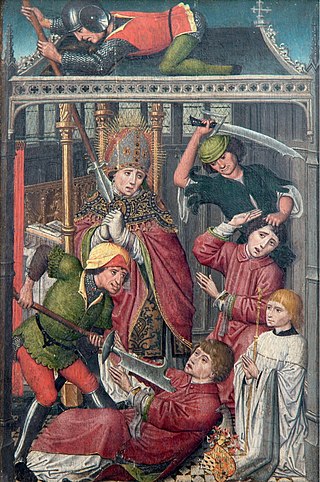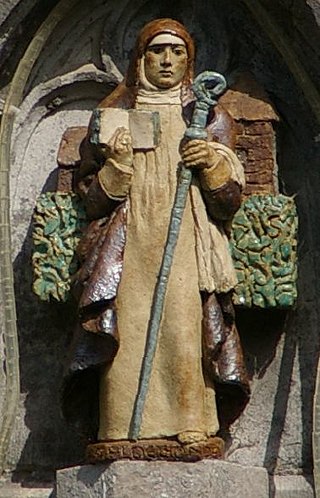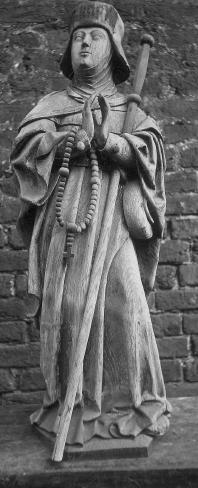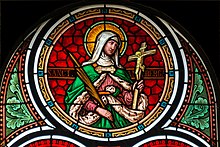Ezzo, sometimes called Ehrenfried, a member of the Ezzonid dynasty, was Count Palatine of Lotharingia from 1015 until his death. As brother-in-law of Emperor Otto III, father of Queen Richeza of Poland and several other illustrious children, he was one of the most important figures of the Rhenish history of his time.

Landgrave was a rank of nobility used in the Holy Roman Empire, and its former territories. The German titles of Landgraf, Markgraf ("margrave"), and Pfalzgraf are of roughly equal rank, subordinate to Herzog ("duke"), and superior to the rank of a Graf ("count").

Lambert of Maastricht, commonly referred to as Saint Lambert, was the bishop of Maastricht-Liège (Tongeren) from about 670 until his death. Lambert denounced Pepin's liaison with his mistress or bigamous wife Alpaida, the mother of Charles Martel. The bishop was murdered during the political turmoil that developed when various families fought for influence as the Merovingian dynasty gave way to the Carolingians. He is considered a martyr for his defence of marriage. His feast day is September 17.

Gudula of Brabant, also known as Saint Gudula, was a Christian saint who is venerated in Catholic and Orthodox churches. In Brabant, she is usually called Goedele or Goule;. Her name is connected to several places: Moorsel, Brussels and Eibingen.

July 9 - Eastern Orthodox Church calendar - July 11

Aldegund, also Aldegundis or Aldegonde, was a Frankish Benedictine abbess who is honored as a saint by the Roman Catholic Church in France and by the Orthodox Church.

Ghislain was a confessor and anchorite in Belgium. He died at the town named after him, Saint-Ghislain.

Saint Pharaildis or Pharailde is an 8th-century Belgian virgin and patron saint of Ghent. Her dates are imprecise, but she lived to a great age and died on January 5 at ninety.

Berlinda was a Benedictine nun of noble descent. Her feast day is 3 February.
Wigeric or Wideric was a Frankish nobleman and the count of the Bidgau and held the rights of a count within the city of Trier. He received also the advocacy of the Abbey of Saint Rumbold at Mechelen from King Charles the Simple of West Francia. From 915 or 916, he was the count palatine of Lotharingia. He was the founder of the House of Ardennes.

Fleury Abbey (Floriacum) in Saint-Benoît-sur-Loire, Loiret, France, founded in about 640, is one of the most celebrated Benedictine monasteries of Western Europe, and possesses the relics of St. Benedict of Nursia. Its site on the banks of the Loire has always made it easily accessible from Orléans, a center of culture unbroken since Roman times. In 2010, the abbey had over forty monks led by the abbot Etienne Ricaud.
The Ezzonids were a dynasty of Lotharingian stock dating back as far as the ninth century. They attained prominence only in the eleventh century, through marriage with the Ottonian dynasty of Holy Roman Emperors. Named after Ezzo, Count Palatine of Lotharingia from 1015 to 1034, they dominated the politics of the middle and lower Rhine and usually represented the royal interests. Under the Salian Emperors, they even briefly held the dukedoms of Swabia, Carinthia, and Bavaria.

Hermann II, Count Palatine of Lotharingia 1064–1085. He was count in the Ruhrgau and the Zulpichgau, as well as a count of Brabant.

Amalberga of Temse, was a consecrated virgin, and possibly an abbess. She is considered a saint. Raised by Saint Landrada, who founded Munsterbilsen Abbey, she refused Charlemagne's offer of marriage. Amalberga became a nun under Landrada and either succeeded her as abbess or governed a community of nuns on her own lands.

Lobbes Abbey was a Benedictine monastery in the municipality of Lobbes, Hainaut, Belgium. The abbey played an important role in the religious, political and religious life of the Prince-Bishopric of Liège, especially around the year 1000. The abbey's founding saint is Saint Landelin; four other saints are also connected with the abbey.
Emebert was an early Bishop of Cambrai, in northern France; he is often identified with Bishop Ablebert of Cambrai.

Reineldis was a saint of the 7th century, martyred by the Huns.

Maubeuge Abbey was a women's monastery in Maubeuge, in the County of Hainaut, now northern France, close to the modern border with Belgium. It is best known today as the abbey founded by St. Aldegonde, still a popular figure of devotion in the region. It is thought to have possibly been where the young Jan Gossaert, a Renaissance-era painter known as Jan Mabuse, was educated, claimed by some to have been a native of the town of Maubeuge, which grew up around the abbey.
Hydulphe, Hydulphus, Hidulphe, Hidulf, commonly known as Hydulphe of Lobbes(French: Hydulphe de Lobbes) was a Frankish saint who helped Saint Landelin establish Lobbes Abbey, Crespin Abbey, and Aulne Abbey.

Aubert of Cambrai or Aubertus was a Merovingian Bishop of Cambrai and Arras and a Frankish saint.















